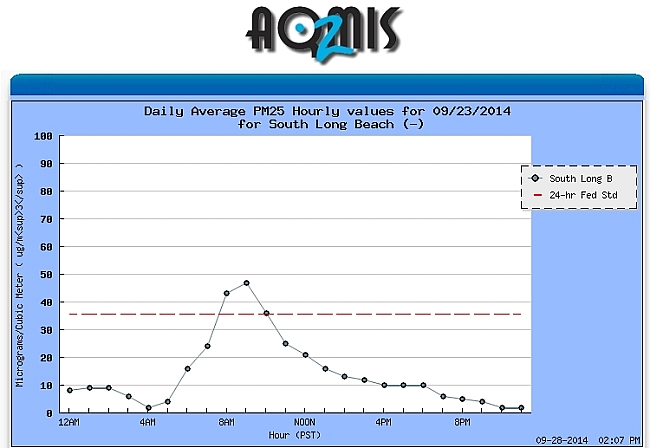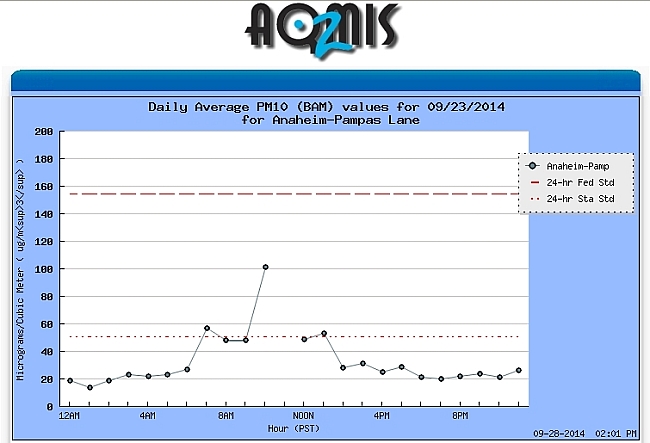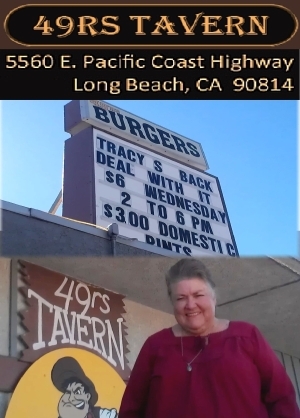SCAQMD's report indicates that smoke from the Port of Los Angeles contained a number of materials. We recommend readers familiarize themselves with information (linked below) from the CDC and EPA websites regarding two items cited by SCAQMD in its report:
SCAQMD indicates its measurements come from three general sources: SCAQMD's current fixed-location Long Beach monitoring site (PCH @ Alamitos), mobile monitors brought to the fire scene and air samples collected in canisters at the fire scene and in the nearby community [which didn't appear to include Long Beach neighborhoods.]
SCAQMD has a fixed location monitor in what it calls "South Long Beach" (1300 block of E. PCH just east of Alamitos Ave.) which records PM2.5 particulates (2.5 microns and smaller.) The monitor doesn't measure PM10 particulates [larger particulates up to 10 microns.]
LBREPORT.com notes that in SCAQMD's July 2014 Annual Air Quality Monitoring Network Plan, the agency itself acknowledges the following regarding its "South Long Beach" monitoring site: "Recent construction of the buildings adjacent to our air monitoring equipment compromises the siting criteria" [p. 37] and the agency indicates it may possibly relocate the South Long Beach monitor to a "more centralized monitoring location in Long Beach" in the future.] Below are the monitor's readings for PM2.5:
Until Sept. 30, 2013, SCAQMD had a monitor in the 3600 block of Long Beach Blvd. which measured PM10, but it's gone (SCAQMD says its lease was terminated at request of building owner.) "As a result some pollutants [measurements] were discontinued while a replacement site is sought," SCAQMD says in its July 2014 Monitoring Network Plan, adding "Consideration is being given to consolidation with nearby sites to better represent the Long Beach area and will be addressed in the 5 year network assessment."
However a state agency, the CA Air Resources Board, has a monitoring site a few miles east of East Long Beach south of Ball Rd. at Euclid St, (west of the I-5 freeway) and it does measure PM10. LBREPORT.com displays below the PM10 readings from the CARB site. (The 11 a.m. hour reading is missing without explanation from the data.)
In its report on the fire and SCAQMD's measurements on Sept. 23, SCAQMD states in pertinent part:
PM2.5 Monitoring
South Long Beach Air Monitoring Station
PM2.5 measurements taken at the SCAQMD South Long Beach air monitoring station indicated that hourly
average of particulate concentrations increased to hourly maximum of 47 micrograms per cubic meter (ug/m3)
at 9am and then declined steadily through the afternoon. The South Long Beach air monitoring station is 5
miles northeast of the location of the fire. Typical concentrations are between 10 and 20 ug/m3 with daily
maximum hourly concentrations around 30 ug/m3. Although there were elevated PM2.5 concentrations for a
few hours, the 24 hour average levels have not exceeded the state and national health standards. The PM2.5
measurement at the station is a Federal Equivalent Method (FEM) which meets U.S. EPA standards for having
results that can be used for comparing against the National Ambient Air Quality Standards (NAAQS).
Portable PM2.5 Monitors (Dustrak)
Measurements using Portable PM2.5 monitors were conducted to assess the pollution from particulates in the
nearby area of the fire. Two instruments were deployed and had conducted quality control checks on site and
comparisons between the two. These are survey instruments used to primarily measure estimates of PM2.5
concentrations.
PM Monitoring at the Site of Fire
In the morning, from 10 am to 10:30 am, PM concentrations were about 6 times the background concentration
with an instantaneous maximum concentration of 14 times higher (208 ug/m3).
Measurements were then taken at a more downwind location near the entrance of the facility, and while the
monitor was downwind of the smoke plume (10:36 am to 11:18 am) , average PM2.5 concentrations observed
were almost 22 times background levels whereby the highest instantaneous reading was over 180 times
(2,870 ug/m3).
The winds shifted at about 11:25 am, blowing the plume due north and the PM2.5 levels at the entrance
declined to lower levels, about 1.5 times background levels, with a maximum of 5 times (85 ug/m3). As the
winds became more calm and stagnant, concentrations briefly increased from 12:18 pm to 12:39 pm to 16
times typical PM2.5 background levels with a maximum instantaneous reading of over 50 times background
values (823 ug/m3).
The smoke intensity then started declining along with the observed PM2.5 concentrations from 12:40 pm to
2:20 pm, the average PM2.5 and the maximum concentration observed were in the typical background PM2.5
concentration range. Monitoring continued at the location until past 4:30 pm which showed PM2.5
concentrations within typical ambient values.
PM Monitoring Away from the Fire
After quality control checks were done, the second PM monitor was deployed at Fries and A Street and
observed levels that were on average almost five times background levels from 10:43 to 11:15 am with the
highest instantaneous reading 12 times higher (192 ug/m3).
>[?The monitor then was moved to George De La Torre Junior Elementary School. Initial readings were elevated
from 11:15 to 11:50 am for which the average was 5.5 times background levels with a maximum instantaneous
level showing 15 times background levels (243 ug/m3). PM levels then declined from 11:51 am to 12:12 pm
which the average was 1.6 times background levels and the maximum instantaneous observed was 3.5 times
background levels (56 ug/m3). PM measurements were taken again at the school at 4:30 pm and showed
concentrations (10 ug/m3) that are consistent with typical ambient levels...
Community Samples
Samples of air collected in the community away from the fire are expected to have lower levels of
hydrocarbons, and thus these samples were sent directly to the GC/MS for a detailed analysis.
The canister collected near the intersection of Harry Bridges and S. Fries contained roughly 70 parts per billion
(ppb) C2 species (organic compounds with two carbon atoms), 20 ppb C3 compounds (organic compounds
with three carbon atoms), 9 ppb acetone. Benzene was 11 ppb, Toluene was 4 ppb, Ethylbenzene was 0.5 ppb,
Xylenes were 1.8 ppb (BTEX); Styrene was 0.9 ppb. Naphthalenes were measured at 21 ppb.
The canister collected near the intersection of C Street and Neptune contained roughly 70 ppb C2 species, 20
ppb C3 compounds, 9 ppb acetone. Benzene was 0.3 ppb, Toluene was 0.3 ppb, Ethylbenzene was 0.1 ppb,
Xylenes were 0.3 ppb (BTEX); Styrene was 0.1 ppb. Naphthalenes were measured at 0.7 ppb.
Near-source Samples
Samples collected in or very near an active fire will yield concentrations that are too high for certain
laboratory-based instruments such as a GC/MS designed for ambient air analysis. The samples collected at the
fire were sent to a screening analysis, which does not include Styrene and Naphthalene.
The canisters collected at the fire site inside the warehouse contained approximately 7.5 parts per million
(ppm) C2, 1 ppm C3 compounds. Benzene was 0.9 ppm, Toluene was 0.2 ppm, Ethylbenzene was 0.04 ppm,
and Xylenes were 0.07 ppm (BTEX).
The canisters collected at the fire site outside the warehouse contained approximately 3 ppm C2, 0.4 ppm C3
compounds. Benzene was 0.3 ppm, Toluene was 0.07 ppm, Ethylbenzene and Xylenes were not detected
(BTEX).
Note these concentrations are orders of magnitude higher than the community samples (ppm vs. ppb).
Portable GC/MS Hydrocarbon Sampling
Based on the canister sample results, it was determined that Naphthalene would be an identifying marker for
the fire. Therefore, while other compounds were measured, only naphthalene is reported below as both an
indicator of exposure to the community as well as fire activity. Listed times are approximate.
9:20 am - Initial sampling was conducted at the fire site, inside the structure by fire department personal, using
SCAQMD measuring equipment. Naphthalene values were too high for the portable GC/MS to accurately
quantify, but were definitely over 100 ppb.
10:30 am - Sample was collected at George De La Torre School (Fries & W. F Street) Naphthalene was
approximately 50 ppb.
11:05 am - Sample collected at Island & D Street. Naphthalene concentration was about 10 ppb.
11:50 am - Sample collected at Wilmington Waterfront Park. Naphthalene was < 10 ppb (below instrumentís
detection limit).
12:30 pm - Sample collected at Lamke and D Streets Naphthalene was < 10 ppb (below instrumentís detection
limit).
2:15 pm - Sample was collected at George De La Torre School. Naphthalene was < 10 ppb (below instrumentís
detection limit).
3:55 pm - Entrance to the dock where the fire was. Naphthalene was < 10 ppb (below instrumentís detection
limit).
4:45 pm - Port of LA headquarters building. Sample file appears to be corrupted Ė results of the two runs (two
attempts at sampling) may not be retrievable.
Sampling Sites requested by LA City Fire personnel on the wharf
5:55 pm -- The sample was collected downwind and near the smoldering portion of the fire. Sample was
approximately 50 ppb naphthalene.
6:40 pm -- Sample collected at a dock, under Vincent Thomas Bridge, upwind of the smoldering area, between
two ships. Naphthalene was < 10 ppb (below instrumentís detection limit).
7:40 pm -- Sample collected at the Vopak terminal. Naphthalene was < 10 ppb (below instrumentís detection
limit).
As reported by LBREPORT.com on Sept. 23:
LBUSD Sup't Chris Steinhauser sent the advisory below to school principals at about 8:50 a.m. on Sept. 23:
LBUSD HQ also shared the AQMD's recent smoke advisory to schools, essentially reiterating the advice to avoid outdoor physical activities.
At midday [after Long Beach residents had inhaled whatever was in the Port fire] SCAQMD issued the following advisory at midday:
















